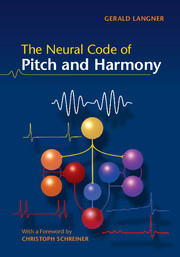Book contents
- Frontmatter
- Contents
- Preface
- Foreword
- 1 Historical aspects of harmony
- 2 Sound and periodicity
- 3 The discovery of the missing fundamental
- 4 The pitch puzzle
- 5 The auditory time constant
- 6 Pathways of hearing
- 7 Periodicity coding in the brainstem
- 8 Periodicity coding in the midbrain
- 9 Theories of periodicity coding
- 10 Periodotopy
- 11 The neural code of harmony
- 12 The oscillating brain
- References
- Index
6 - Pathways of hearing
Published online by Cambridge University Press: 05 May 2015
- Frontmatter
- Contents
- Preface
- Foreword
- 1 Historical aspects of harmony
- 2 Sound and periodicity
- 3 The discovery of the missing fundamental
- 4 The pitch puzzle
- 5 The auditory time constant
- 6 Pathways of hearing
- 7 Periodicity coding in the brainstem
- 8 Periodicity coding in the midbrain
- 9 Theories of periodicity coding
- 10 Periodotopy
- 11 The neural code of harmony
- 12 The oscillating brain
- References
- Index
Summary
From the cochlea to the cortex
Acoustic signals transferred from the outer to the inner ear elicit neural signals in the cochlea that travel in the form of nerve impulses along the auditory pathways. They follow ascending fibre tracts from the brainstem to the midbrain and from there through the thalamus to the cerebral cortex (Fig. 6.1). Each of these fibre tracts contains many thousands of nerve fibres (axons) that connect the nerve cells of a series of auditory processing centres (nuclei).
The auditory nerve connects the cochlea with the entrance station to the central auditory system, the cochlear nucleus (CN). From here, acoustic information travels to the inferior colliculus via both direct and indirect routes. This midbrain nucleus is a major processing centre for all auditory information on its way to the cortex. It receives input from the CN on both sides, from the nuclei of the lateral lemniscus and also from the superior olivary complex (containing binaural information). As we will see (Chapters 8–11), the inferior colliculus also plays a central role in periodicity processing and therefore also in this book.
The next level of the auditory pathway is the medial geniculate body, located in the thalamus. This nucleus is often considered as the gateway to the auditory cortex that forms part of the cortical temporal lobe. Here fundamental acoustic features like timbre, pitch, loudness and localization, which have already been analysed in the lower processing centres, are processed further. Finally, fibres of descending (efferent) pathways course downwards from the cortex and other auditory areas to in fluence the lower processing centres. They provide a negative feedback, or inhibitory control, which in fluences the sensitivity and selectivity of these nuclei.
The ear
The receiving system
Our ear consists of three main parts: the outer, middle and the inner ear (Fig. 6.2). The pinna and ear canal of the outer ear collect sound waves and guide them to the eardrum (tympanic membrane).
Information
- Type
- Chapter
- Information
- The Neural Code of Pitch and Harmony , pp. 60 - 87Publisher: Cambridge University PressPrint publication year: 2015
